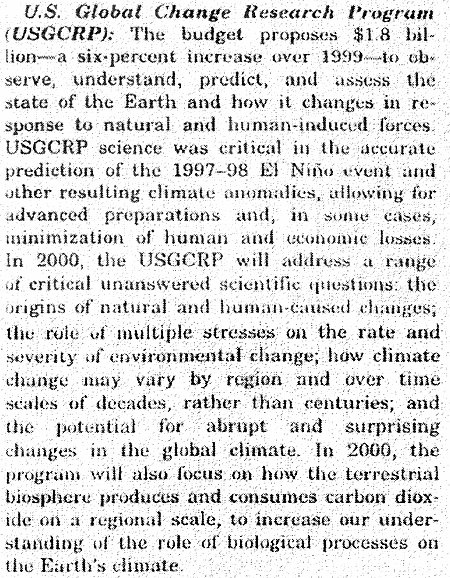National Science and Technology Council Interagency Initiatives
The National Science and Technology Council provides management oversight that will ensure efficient and effective coordination for key multi-agency initiatives, including;
High Performance Computing and Communications (HPCC) and the Information Technology Initiative: The budget provides $1.8 billion for these programs, including $366 million for the Information Technology Initiative, a bold, new effort focused on two, interrelated topics; 1) fundamental research that could lead to major breakthroughts in the next generation of supercomputers, networks and applications - research that is too high-risk and/or long-term for private sector funding; and 2) development of extremely powerful supercomputers, hundreds and times more powerful than today's best, for applications in a variety of cilivian fields. Resulting advances in these fields could lead, for example, to better predictions of global warming and regional weather, as well as improved pharmaceutical development. The continuing HPCC program will pursue breakthroughts in high-end computing and computation, large-scale networking, and high-confidence systems. This ongoing work includes the Next Generation Internet Initiative. In the last year, the program demonstrated many key components of the Next Generation Internet, including ultra-high-speed switching devices, and various data-intensive applications ranging from medical imaging to advanced storm forecasting.

Climate Change Technology Initiative: The budget proposses $1.8 billion for the second year of this research and technology initiative to promote energy efficiency, develop low-carbon energy sources,and develop and demonstrate technologies to reduce greenhouse gas emissions. Led by DOE and EPA, the effort also includes USDA, the Department of Housing and Urban Development, and NIST. Of the amount proposed, $1.4 billion is for R&D spending on energy efficiency and renewable energy technologies, sequestration (storage) of carbon, extending the useful life of existing nuclear plants, and development of highly efficient fossil fuel technologies. The remainder, $0.4 billion, is for tax credits to stimulate the adoption of energy efficient technologies in buildings, homes, industrial processes, vehicles, and power generation.
Partnership for a New Generation of Vehicles: The budget proposes $264 million - $24 million more than in 1999 - for this cost-shared, industry partnership, which centers on three research goals: to develop advanced manufacturing techniques; to use new technologies for near-term emissions improvements; and to develop production prototype vehicles three times nore fuel-efficient than today's cars, with no sacrifice in comfort, performance, or price. Federal funding focuses mainly on the third goal. In the last year, the automobile companies completed hybrid drivetrain proto-type development and have moved further development in-house, requiring no more Federal support for these activities. Federal funding is now focusing on timely development of crucial components such as low-emissions direct-injection engines, fuel cells, power electronics, batteries, and lightweight materials. The program will lead to concept cars in 2000, and production prototypes in 2004.